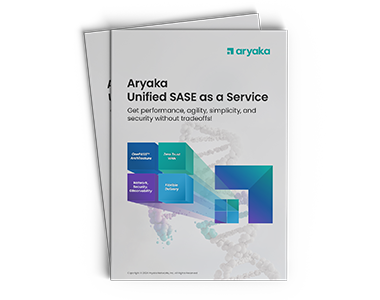The Convergence of Networking and Security in Unified SASE Architecture

The traditional network perimeter is in shambles and what remains is a wild west of unmanaged devices, assets scattered around your private and public clouds, unreadable application traffic runs rampant, and hybrid work structures are straining the capabilities of your existing network.
What’s more, these issues were on the rise long before the new hurdles of generative AI and large language models were introduced to the public. Now every office worker, pet store owner, social media influencer, and coffee shop barista has access to unimaginable processing power capable of churning countless terabytes of data, putting all new strains on global networks.
These digital transformations have simultaneously boosted and hindered business productivity in different ways, while legacy network and security architectures are struggling to keep up. The good news is that a solution already exists.
Secure Access Service Edge is the Answer
Conquering this challenging landscape requires shifting to a cloud-first strategy of network and security convergence known as Secure Access Service Edge, or SASE. Secure Access Service Edge is an architectural framework that integrates networking and security capabilities with a multi-cloud approach in mind. At the core, SASE is underpinned by the principles of zero trust complete visibility, centralized management, streamlined software defined networks, and security that lives on the edge of where systems are accessed.
Let’s explore the key components of SASE, the benefits of integrating your networking and security infrastructures, and the importance of a unified SASE approach built for the modern enterprise.
The SASE Framework: An Overview
SASE, introduced by Gartner in 2019, is a comprehensive framework that combines software-defined wide area networking (SD-WAN) capabilities with a suite of security services known as Security Service Edge (SSE), including:
- Cloud Access Security Broker (CASB): CASB provides visibility, control, and protection for cloud applications, providing data security, hardening access, and ensuring regulatory compliance.
- Secure Web Gateway (SWG): SWG enforces web security policies, filters malicious content, and protects users from web-based threats.
- Zero Trust Network Access (ZTNA): ZTNA enables secure, granular access to applications and resources based on the principle of least privilege and continuous identity verification.
- Firewall as a Service (FWaaS): FWaaS delivers next-generation firewall capabilities, such as intrusion prevention and advanced threat protection, as a cloud service.
By integrating these security services with SD-WAN, SASE creates a distributed architecture that simplifies network management, improves performance, and enhances security posture, protects your data, and adapts to your unique multi-cloud infrastructure as it changes.
The 7 Benefits of Integrating Networking and Security
Traditionally, networking and security have been managed as separate domains, leading to complexity, inconsistency, and gaps in protection. The convergence of networking and security in SASE offers several key benefits:
- Simplified Management: With a unified platform, IT teams can manage networking and security policies from a single pane of glass, reducing complexity and improving efficiency.
- Consistent Security Policies: SASE enables the consistent enforcement of security policies across all users, devices, and locations, eliminating the risk of inconsistencies and gaps.
- Increased Visibility: The use of a single vendor unified platform eliminates the multi-dashboard, bolt-on approach to network and application traffic monitoring. This creates a seamless single pane of glass view of your entire environment.
- Improved Performance: By integrating security functions with SD-WAN, Unified SASE optimizes network performance, reduces latency, and enhances the user experience.
- Scalability and Agility: SASE’s cloud-native architecture allows organizations to quickly scale their networking and security capabilities to meet changing business needs.
- Reduced Costs: Consolidating multiple point solutions into a single, cloud-delivered service can significantly reduce capital expenditures and operational costs.
- Future Proof Capabilities: The world of cloud computing is rapidly evolving, especially with the widespread adoption of generative AI and large language models. SASE creates a streamlined and scalable approach that future proofs your network and security for new resource intensive technologies and capabilities.
Secure Access Service Edge is the future of networking and security. This architecture is not only addressing the gaps created by older network models but is also creating a more agile business infrastructure built to adapt as quickly as you adapt to shifting priorities, new customers, and even novel cyber-attacks.
The Importance of a Unified SASE Solution
In recent years, SASE has been colloquially understood as a collection of security capabilities and often confused with “Security Service Edge” (SSE). SSE is the security half of the SASE equation and typically dominates the conversation. Unfortunately, in many cases the SD-WAN component is only integrated as an afterthought.
While SASE can be implemented using a combination of point solutions from various vendors, a unified SASE solution offers distinct advantages:
- Pre-Integrated Components: A unified solution ensures seamless integration between networking and security functions, eliminating the need for complex configurations and reducing the risk of compatibility issues.
- Single-Vendor Accountability: With a unified solution, organizations have a single point of contact for support, troubleshooting, issue resolution, streamlining the management process.
- Optimized Performance: A unified solution is designed to optimize the interplay between networking and security functions, minimizing latency and maximizing performance.
- Simplified Adoption: Implementing a unified solution is often simpler and faster than integrating multiple point solutions, accelerating time-to-value and reducing the learning curve for IT teams.
The Difference Between Unified SASE and “Sorta” SASE
By and large, the market is still operating on an outdated mindset of bolting on new security functions to their existing HQ/branch MPLS network or public internet-based WAN stitched together using IPsec tunneling between firewalls. This creates a network and security architecture resembling a complicated Mad Max, rat rod style conglomeration of different vendors, appliances, portals, and dashboards.
Sure, it functionally works, but does it work well? We don’t think so. This is what we see happening when only approaching SASE from a security perspective with networking as an afterthought.
At Aryaka, we believe the discussion must move beyond “SASE” , to Unified SASE as a Service with a dedicated global network complete with native security capability, centralized management and access control, and a single pane of glass for robust security and networking observability all delivered in any combination of a self-managed, a co-managed or fully managed service.

Unified SASE as a Service is more than just a mish mash of bolt-on security functions, mixed appliance boxes, and leased rack space in a data center somewhere. It’s an architectural philosophy that prioritizes ease of operation and adoption, while creating a truly converged experience delivering performance, agility, simplicity and security over global networks.
Aryaka Unified SASE as a Service is built from the ground up to provide this frictionless security and network experience that adapts as you do and protects you every step of the way.
Learn More about Unified SASE as a Service from the Aryaka Perspective
The convergence of networking and security in SASE represents a paradigm shift in how organizations approach network architecture and security. By integrating critical functions into a unified, cloud-delivered service, SASE simplifies management, improves performance, and enhances security posture. As enterprises continue to navigate the challenges of digital transformation, adopting a unified SASE solution will be crucial for success.
The good news is we have big things coming up for Aryaka Unified SASE as a Service where we’ll showcase new additions to our solution, where we help you consolidate your operations, reduce costs, and fortify your security posture with new security features..



